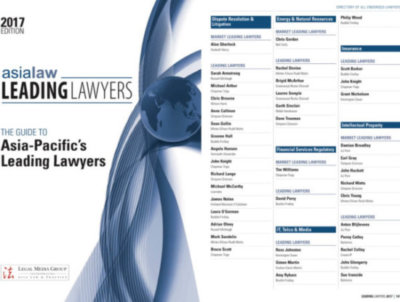China’s new trade mark laws came into effect on 1 May 2014.
The main change is that prosecution timelines have been considerably shortened to “speed up” the process, which should be good news for New Zealand business seeking to protect their trade marks in China, where traditionally it’s taken up to two years to get a trade mark registration. Other changes should result in reduced official fees and cost savings for clients.
However, while speeding up the registration process is undoubtedly beneficial, the real impact for NZ businesses/their IP advisors is that we need to really be on our toes in responding to Examination Reports/filing appeals against Examiner’s rejections of applications in a timely manner.
Prosecution
Sound trade marks will now be protectable in China, as they are in New Zealand. (In addition to traditional marks, such as words and logos, China currently permits applications to register colours and 3D shapes as trade marks.)
Multi-class applications will be allowed, which should significantly reduce filing and prosecution costs.
There will be a time limit (of between 9 to 18 months) placed on the Trade Marks Office (TMO) for examining trade mark applications, and on Trade Marks Review and Adjudication Board (TRAB) for reviewing appeals to the refusal of trade mark applications and considering oppositions.
Given that there has traditionally been little scope to address the substantive objections raised during examination (other than, for example, to delete goods/services or to file an appeal against the refusal of an application), a shorter prosecution time is good for businesses.
Again, as the appeal review and opposition processes provide small windows of opportunity in which to submit supporting arguments and evidence, these time limitations are also advantageous.
 The deadline to respond to Examination Reports/Office Actions issued by the TMO will reduce from 30 days to 15 days, and the deadline to file an appeal to the TRAB once an application has been refusedremains 15 days from the date of rejection of the application.
The deadline to respond to Examination Reports/Office Actions issued by the TMO will reduce from 30 days to 15 days, and the deadline to file an appeal to the TRAB once an application has been refusedremains 15 days from the date of rejection of the application.
Where a review of a refused trade mark application is requested, and where the TRAB indicates the review is partially successful, the trade mark applicant can apply to split its application within 15 days. This will at least provide trade mark protection for some of the goods/services of the application and is akin to the ‘dividing out’ process allowed by IP Australia and IPONZ.
Renewals
Under the new law, the window to renew a trade mark registration will be extended to 12 months before the expiry date. For businesses having large portfolios of registered trade marks, including Chinese marks, this should bring flexibility and cost savings to the renewal process.
Opposition
Under the new law, where an opposition is raised based on relative grounds (such as the existence of a prior registration), only pre-existing rights holders and other interested parties can be party to the opposition.
The deadline for filing supplemental evidence and submissions in support of a trade mark opposition or in support of an application for review of a refused application will be shortened from 3 months to 30 days. This will place significant pressure on opponents, or applicants of refused applications, to collate evidence quickly.
Note: There may be an opportunity to submit evidence after the 30 day deadline, but the evidence will only be considered if it has a substantial impact on the opposition decision.
Also, if an opposition is filed in respect of only some of the designated goods/services, the trade mark applicant is allowed to apply to split its application within 15 days upon receipt of the Ground(s) of Opposition from the TMO. Thus, the opposed application will be allowed to proceed to registration in respect of the unopposed goods/services.
Where an opposition is unsuccessful, it will no longer be possible to request a further judicial review. The only option to proceed will be to request invalidation.
Invalidation
A trade mark ‘invalidation’ procedure replaces the current ‘cancellation’ procedure.
The TMO or any party can raise an invalidation action under absolute grounds (such as a lack of distinctiveness, or that a registration was obtained through fraudulent or unfair means). Only pre-existing rights holders and other interested parties can file a request for invalidation under relative grounds within five years from the date of registration.
However, where a well-known mark is registered in bad faith, the genuine owner of the mark shall not be restricted by this five year limitation.
An appeal to an invalidation action can be filed by the trade mark registrant with the TRAB. The TRAB will be subject to reduced time limitations (between 9 to 12 months) in considering the appeal.
Licensing
The new law formalises the requirement to record trade mark licences with the TMO. A licence, which has not been recorded, cannot be used by the licensee to enforce trade mark rights against a third party.
Assignment
Where a registered trade mark is assigned, the assignor is now required to assign all identical or similar registered trade marks in respect of the same or similar goods.
Supposedly, this requirement has been introduced to ‘maintain market order’, however it could represent an unnecessary burden for some businesses.
Enforcement
The new law introduces defences to infringement. Similar to the New Zealand Trade Marks Act 2002, a person will not infringe a registered trade mark if prior use of the mark before the date of filing can be established. This may provide some relief where a business has used an unregistered mark in China, and where the mark is subsequently registered by a third party in bad faith.
Where an allegation of infringement is made, the trade mark owner can now be made to provide evidence of use of the mark within the previous three year period. If evidence of use cannot be provided, the alleged infringer is not required to pay compensation.
It is unclear as to the level of use required to support an infringement action. In certain circumstances in New Zealand and Australia, a single, bona fide use of a trade mark is sufficient to rebut an allegation of non-use.
A provision for ‘contributory infringement’ has been added to the new law, where assisting or providing conditions to facilitate infringement are considered offences.
This should catch manufacturers/counterfeiters, and allow for action to be taken against them too.
 The Chinese Administration for Industry and Commerce (an administrative body) will be able to issue fines against infringing parties.
The Chinese Administration for Industry and Commerce (an administrative body) will be able to issue fines against infringing parties.
The limit for statutory compensation will increase six-fold from RMB500,000 to RMB3,000,000. The new law also introduces the concept of punitive damages, which can be up to three times actual damages in serious cases of infringement.
While Chinese law does not provide for ‘discovery’, when deciding on compensation, a court will now be able to request that an alleged infringer provide accounting books or other materials. If the alleged infringer fails to provide books/materials, or provides counterfeit books/materials, the court can judge the compensation based on the claims and evidence provided by the plaintiff.






